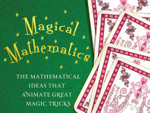 Persi Diaconis, the Stanford professor who discovered that 7 riffle shuffles are the minimum required to properly mix the deck, and Ron Graham, the UCSD professor who popularized the Erdős number concept (The mathematical world's equivalent of a Kevin Bacon number), have just released a much-talked about book titled Magical Mathematics.
Persi Diaconis, the Stanford professor who discovered that 7 riffle shuffles are the minimum required to properly mix the deck, and Ron Graham, the UCSD professor who popularized the Erdős number concept (The mathematical world's equivalent of a Kevin Bacon number), have just released a much-talked about book titled Magical Mathematics.
Is it any good? No less than the late, great founder of the field of recreational mathematics himself, Martin Gardner himself wrote the foreword, so it is definitely worth a closer look.
The first thing you notice about this book, especially if you've read previous books on math-based magic effects, is that it doesn't simply stop at explaining the effect and simply stating the mathematical principle. Magical Mathematics' strength is the way in which is delves into the principle to help you develop a better understanding, which in turn can help you spur your own creativity.
Each chapter in the first half of the book is dedicated to one particular type of principle, such as cycles, shuffling, or codes. In the later chapters, the book tends toward discussions of ideas related to those in the earlier chapters. In this latter part of the book, you learn about things like magic routines involving the I Ching, prominent people in the history of mathematical magic, and even the math behind juggling!
Grey Matters readers will recognize many of the names and principles included in this book, such as:
• Martin Gardner (of course)
• The Gilbreath Principle
• Stewart James and his effect Miraskill
• Bob Hummer and his 3-Card Monte
• Robert Neale and his Rock Paper Scissors routine
If you find you like de Bruijn Sequences, you may want to check out Leo Boudreau's work, which you can find online, as well as in his books.
Despite the cover, and even the impression you might get for quickly perusing the book, the routines aren't just limited to card tricks. There are effect here with pencil and paper, origami, chains, and many other items. Even some of the card tricks, once you understand the principle behind them, can be adapted to other objects.
The best thing about Magical Mathematics is that you can take your understanding of the trick as far as you want. Do you want to understand just enough of the effect to perform it without understanding the math? The authors describe each effect and method before explaining the mathematical basis.
Perhaps you prefer to understand the principle better so that you can create your own variations. You can take yourself through the full explanation, or even only part way if you prefer, and find inspiration either way.
If you enjoy my posts on recreational math and magic, I have no doubt you will enjoy and find great value in Magical Mathematics.
Magical Mathematics retails for $29.95, including the PDF and EPUB versions, but you can obtain the hardcover version and Kindle edition for a lower price.
To help give you a better idea of the value of this book, I've posted a Google Books preview of it below. Some of the pictures in the first chapter are removed for copyright reasons, but the publisher, Princeton University Press, has generously made the entire first chapter, including images, available for free (PDF).
0
Review: Magical Mathematics
Published on Sunday, November 06, 2011 in books, downloads, fun, magic, Martin Gardner, math, playing cards, products, reviews
Related Posts
Post Details
Posted by Pi Guy on Nov 6, 2011
Labels:
books,
downloads,
fun,
magic,
Martin Gardner,
math,
playing cards,
products,
reviews
Subscribe to:
Post Comments (Atom)




No Response to "Review: Magical Mathematics"
Post a Comment